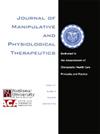轻度和中重度头后仰患者的感觉组织和姿势控制策略:比较研究。
IF 1.4
4区 医学
Q4 HEALTH CARE SCIENCES & SERVICES
Journal of Manipulative and Physiological Therapeutics
Pub Date : 2023-05-01
DOI:10.1016/j.jmpt.2024.02.004
引用次数: 0
摘要
研究目的本研究旨在比较轻度和中重度前头姿势(FHP)患者的感觉组织测试和姿势控制策略:方法:在 6 种情况下使用计算机化动态体位测量法进行感觉组织测试 (SOT),以评估姿势控制能力。结果:我们的研究结果表明,在 6 种情况下,踝关节与髋关节的策略优势明显不同:结果表明,在 SOT 的 4 至 6 项条件中,两组在平衡得分(P < .05)和策略得分(P < .05)方面存在显著差异。SOT的感官分析结果显示,视觉和前庭比率在两个研究组之间存在显著差异(P < .05),但体感和视觉偏好比率在两个研究组之间没有显著差异(P > .05):结论:与轻度 FHP 患者相比,中重度 FHP 患者在 SOT 的摇摆参照平台条件下摇摆得更厉害。当感觉困难程度增加时,他们倾向于过度依赖髋部策略,而不是踝部策略。总之,可以得出结论,中重度 FHP 患者更容易出现姿势障碍。本文章由计算机程序翻译,如有差异,请以英文原文为准。
Sensory Organization and Postural Control Strategies in Individuals With Mild and Moderate-to-Severe Forward Head Posture: A Comparative Study
Objective
This study aimed to compare sensory organization test and postural control strategies between individuals with mild and moderate-to-severe forward head posture (FHP).
Methods
A sensory organization test (SOT) was performed in 6 conditions using computerized dynamic posturography, to assess postural control. Equilibrium scores representing overall balance, strategy analysis to assess ankle vs hip strategy dominance, and sensory analysis (Somatosensory, visual, vestibular, visual preference ratio) as an indicator of the use of sensory systems were obtained.
Results
Our results revealed a significant difference between the 2 groups in terms of equilibrium score (P < .05) and strategy scores (P < .05) in conditions of 4 to 6 of the SOT. The results of sensory analysis of SOT showed visual and vestibular ratios were significantly different between the 2 study groups (P < .05), but somatosensory and visual preference ratios were not significantly different between these 2 groups (P > .05).
Conclusion
Individuals with moderate-to-severe FHP swayed more in comparison with mild FHP ones in conditions with the Sway-referenced platform of the SOT. They tended to rely on the hip strategy more than the ankle strategy excessively when sensory difficulty increased. Overall, it can be concluded that individuals with moderate-to-severe FHP are more likely to have postural deficits.
求助全文
通过发布文献求助,成功后即可免费获取论文全文。
去求助
来源期刊
CiteScore
3.00
自引率
7.70%
发文量
63
审稿时长
29 weeks
期刊介绍:
The Journal of Manipulative and Physiological Therapeutics (JMPT) is an international and interdisciplinary journal dedicated to the advancement of conservative health care principles and practices. The JMPT is the premier biomedical publication in the chiropractic profession and publishes peer reviewed, research articles and the Journal''s editorial board includes leading researchers from around the world.
The Journal publishes original primary research and review articles of the highest quality in relevant topic areas. The JMPT addresses practitioners and researchers needs by adding to their clinical and basic science knowledge and by informing them about relevant issues that influence health care practices.

 求助内容:
求助内容: 应助结果提醒方式:
应助结果提醒方式:


